TSUKIJI OUTER MARKET (築地場外市場), Tokyo (東京), Japan, 2019.06.15
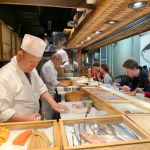
Day 1 (1/2).
Our flight landed in Tokyo Haneda at around 6am. Before our next flight to Hokkaido’s Memanbetsu Airport at noontime, we had a few hours to spare in the Japanese capital. Tsuyu (梅雨), the rainy season in Japan, was in full force in mid June. Given the proximity to the city centre, we wouldn’t want to miss the chance of revisiting Tokyo. We took the monorail and then transferred to the metro heading for Tsukiji Market. 40 minutes was all it took to reach Tsukiji. It was pouring when we came out the metro at the Kabuki-za Theatre (歌舞伎座) exit. We followed Google Map to make our way into the quiet lanes near the outer market.
Opened in 1935, the 83-year-old market has officially moved to the new Toyosu Market (豊洲市場) in October 2018. With no intention to watched a tuna auction behind glass or checked out seafood and produce stores in a brand new shopping centre like setting, we preferred to revisit the old market at Tsukiji, where the Outer Market remained open for business. At the market, generations of social interactions have developed a strong sense of community. The chaotic turret traffic at the inner market, desperate tourists cramped in long lines for an early sashimi breakfast, cafes serving simple coffee on dark wood counters, street food stalls along busy lanes and covered alleyways, the spirit and ambience of the old market have drawn us back to Tsukiji again and again. This time around, our Tsukiji experience took us to a craft coffee shop, a back lane sushi eatery and a historical Shinto shrine.
 Miraitowa (future and eternity) and Someity (calm and powerful), the two official mascot of 2020 Tokyo Summer Olympics, greeted all visitors at the arrival lobby of Haneda Airport.
Miraitowa (future and eternity) and Someity (calm and powerful), the two official mascot of 2020 Tokyo Summer Olympics, greeted all visitors at the arrival lobby of Haneda Airport.
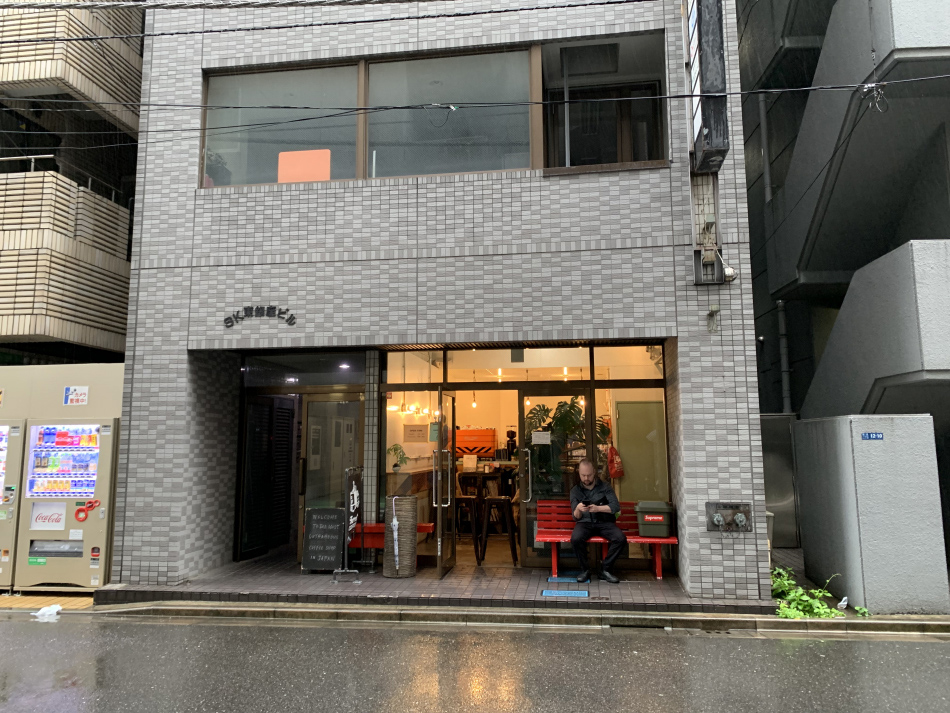 Turret COFFEE, a popular hub for everyone in Tsukiji who love coffee, offered us a decent dose of caffeine to start the day.
Turret COFFEE, a popular hub for everyone in Tsukiji who love coffee, offered us a decent dose of caffeine to start the day.
 We came just in time to be the first few customers at Turret.
We came just in time to be the first few customers at Turret.
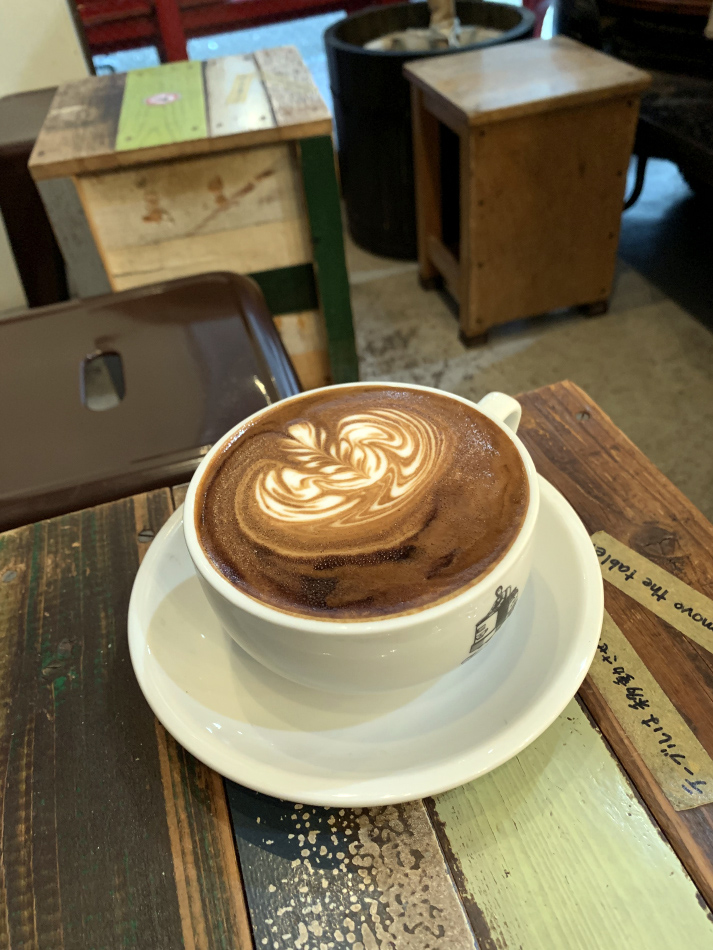 The cafe decor was simple and the coffee was aromatic and good.
The cafe decor was simple and the coffee was aromatic and good.
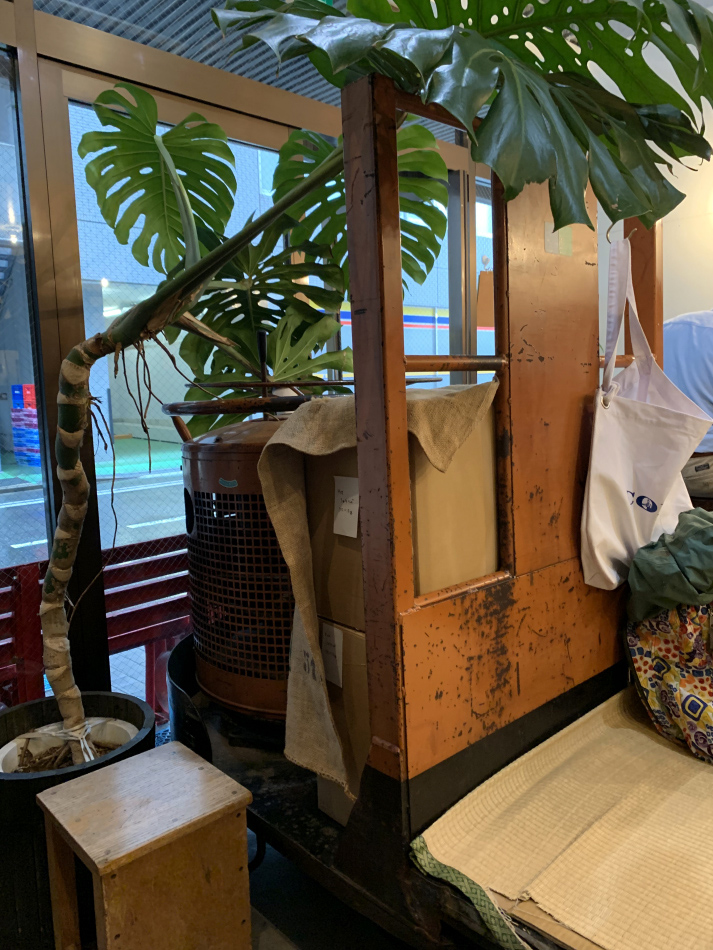 Named after the 3-wheel cart that once roamed in the lanes of Tsukiji Market, a real “turret” was placed in the centre of the coffee shop as display and also seating.
Named after the 3-wheel cart that once roamed in the lanes of Tsukiji Market, a real “turret” was placed in the centre of the coffee shop as display and also seating.
 Kitsuneya Beef Rice, one of the most popular eateries in the entire outer market, offers visitors a decent alternative to seafood.
Kitsuneya Beef Rice, one of the most popular eateries in the entire outer market, offers visitors a decent alternative to seafood.
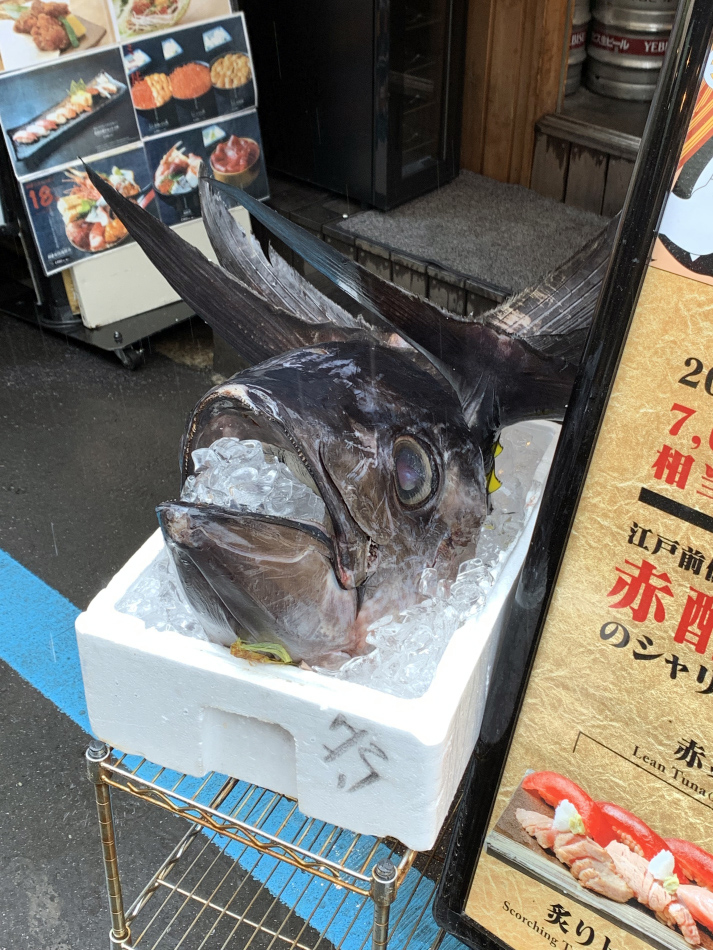 For many, leaving Tsukiji Market without picking up several pieces of tuna toro sashimi would be a big regret.
For many, leaving Tsukiji Market without picking up several pieces of tuna toro sashimi would be a big regret.
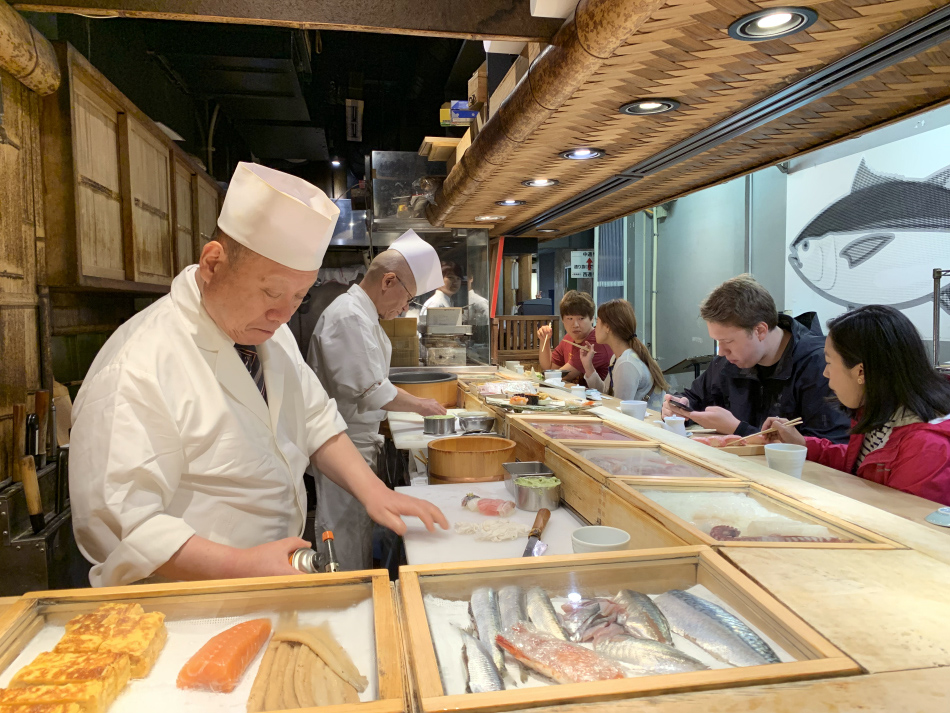 We ended up sitting down at a small sushi eatery in a covered alleyway.
We ended up sitting down at a small sushi eatery in a covered alleyway.
 Despite relocation of the inner market, the sushi at Tsukiji Outer Market was equally fresh as before.
Despite relocation of the inner market, the sushi at Tsukiji Outer Market was equally fresh as before.
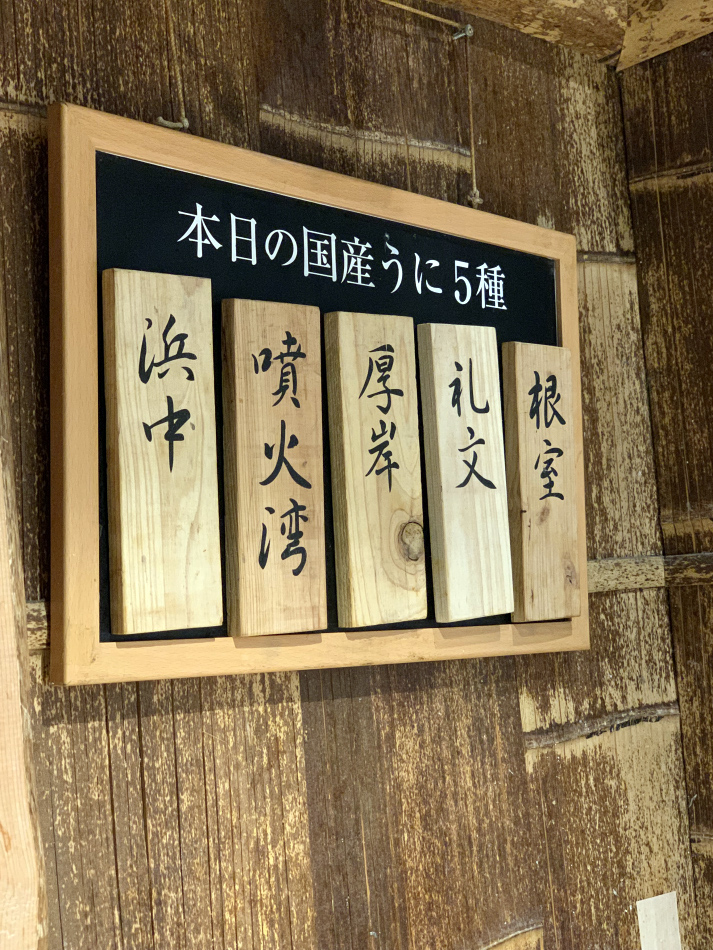 Today’s uni (sea urchin): Hamanaka (浜中), Uchiura Bay (噴火湾), Akkeshi (厚岸), Nemuro (根室), Rebun (礼文), and Nemuro (根室). Even looking at the names of the five fishing villages in Hokkaido would wet our appetite.
Today’s uni (sea urchin): Hamanaka (浜中), Uchiura Bay (噴火湾), Akkeshi (厚岸), Nemuro (根室), Rebun (礼文), and Nemuro (根室). Even looking at the names of the five fishing villages in Hokkaido would wet our appetite.
 Before returning to the airport, we made a stop at Namiyoke Inari Jinja (波除稲荷神社), the unofficial guardian shrine of Tsukiji Market.
Before returning to the airport, we made a stop at Namiyoke Inari Jinja (波除稲荷神社), the unofficial guardian shrine of Tsukiji Market.
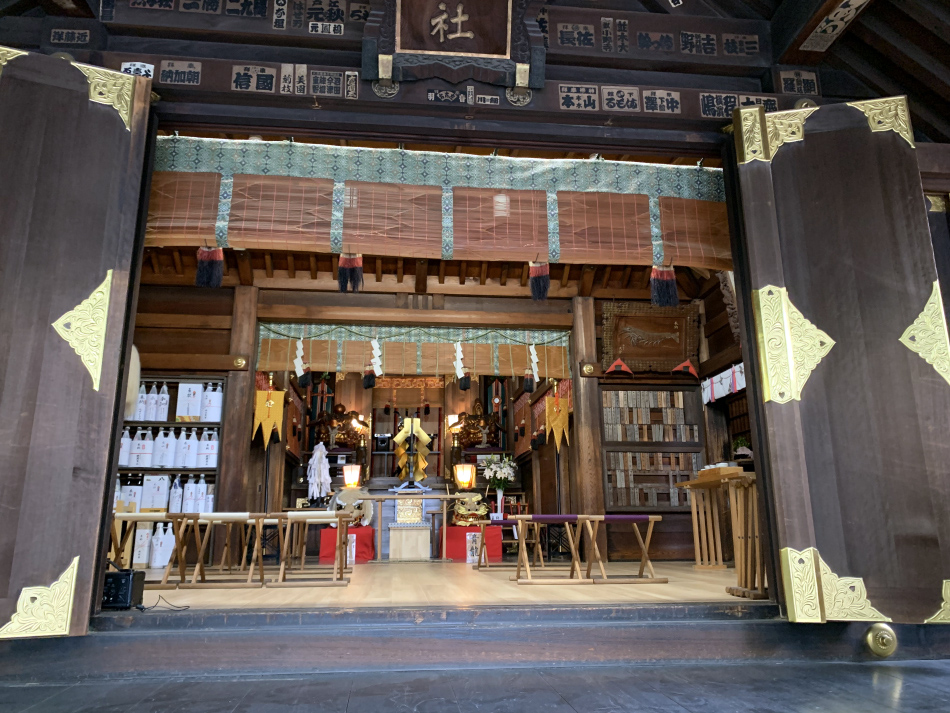 Built in 1659, the Shinto shrine dedicates to Inari (稲荷大神), the god of fertility, rice, tea, sake, agriculture. The Namiyoke Inari Jinja (波除稲荷神社) was specifically aimed to ward off disasters and diminish incoming waves.
Built in 1659, the Shinto shrine dedicates to Inari (稲荷大神), the god of fertility, rice, tea, sake, agriculture. The Namiyoke Inari Jinja (波除稲荷神社) was specifically aimed to ward off disasters and diminish incoming waves.
 The 1-ton Yakuyoke Tenjo Dai-Shishi male lion is one of the main features of the shrine. During Tsukiji Lion Festival on June 10th, the lion head would parade across the Tsukiji along with the red female lion head.
The 1-ton Yakuyoke Tenjo Dai-Shishi male lion is one of the main features of the shrine. During Tsukiji Lion Festival on June 10th, the lion head would parade across the Tsukiji along with the red female lion head.
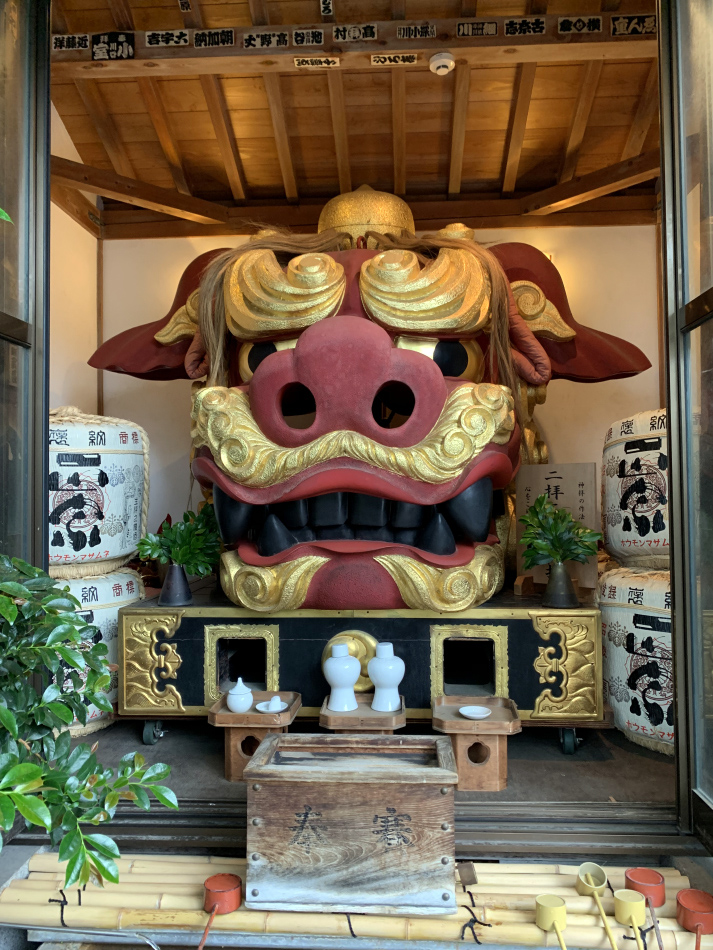 The 0.7 ton female lion head is slightly lighter than the male, but equally impressive. After coffee, sushi, and Shinto shrine, we took our time to return to Haneda Airport for the flight to Memanbetsu in Hokkaido.
The 0.7 ton female lion head is slightly lighter than the male, but equally impressive. After coffee, sushi, and Shinto shrine, we took our time to return to Haneda Airport for the flight to Memanbetsu in Hokkaido.
* * *
Introduction
HOKKAIDO ROAD TRIP, Hokkaido (北海道)
Day 1 – from Tokyo to Shiretoko Peninsula
Day 1.1 TSUKIJI OUTER MARKET (築地場外市場)
Day 1.2 ARRIVAL IN SHIRETOKO, Utoro (ウトロ)
Day 2 – Utoro
Day 2.1 SHIRETOKO FIVE LAKES (知床五湖)
Day 2.2 UTORO FISHERMAN’S WIVES CO-OPERATIVE DINER (ウトロ漁協婦人部食堂)
Day 2.3 FUREPE FALLS (フレペの滝)
Day 3 – Rausu
Day 3.1 RUSA FIELD HOUSE (ルサフィールドハウス)
Day 3.2 JUN NO BANYA (純の番屋)
Day 4 – Rausu
Day 4.1 MOUNT RAUSU (羅臼岳)
Day 4.2 FANTASTIC ORCAS, Nemuro Strait (根室海峡)
Day 5 – Lake Mashu & Lake Akan
Day 5.1 SUNRISE AT LAKE MASHU (摩周湖)
Day 5.2 MOUNT MASHU TRAIL (摩周岳) , Teshikaga (弟子屈)
Day 5.3 SILENT NIGHT AT LAKE AKAN (阿寒湖)
Day 6 – On the road from Lake Akan to Furano
Day 6.1 FISHERMEN BELOW MISTY OAKAN (雄阿寒岳), Lake Akan (阿寒湖)
Day 6.2 TREATS OF OBIHIRO (帯広), Tokachi (十勝)
Day 6.3 ARRIVING IN FURANO (富良野)
Day 7 Furano & Biei
Day 7.1 LAVENDER BUDS, Nakafurano (中富良野)
Day 7.2 FARM TOMITA (ファーム富田), Nakafurano (中富良野)
Day 7.3 BI.BLE, Biei (美瑛)
Day 7.4 PATCHWORK ROAD & PANORAMA ROAD, Biei (美瑛)
Day 7.5 NINGLE TERRACE (ニングルテラス)
Day 8 – from Furano to Otaru
Day 8.1 CHURCH ON THE WATER (水の教会), Hoshino Resorts Tomamu (星野リゾート トマム)
Day 8.2 HILL OF THE BUDDHA (頭大仏), Makomanai Takino Cemetery (真駒内滝野霊園)
Day 8.3 SEAFOOD, CANAL, & HISTORY, Otaru (小樽)
Day 8.4 RAINY NIGHT IN OTARU, Otaru (小樽)
Day 9 – Yochi & Sapporo
Day 9.1 NIKKA YOICHI DISTILLERY (余市蒸溜所), Yoichi (余市)
Day 9.2 SOUP CURRY NIGHT
Day 10 – Sapporo
10.1 OKKAIDO SHRINE (北海道神宮 )
10.2 MORIHICO COFFEE (森彦珈琲本店)
10.3 KITAKARO SAPPORO HONKAN (北菓楼札幌本館)
10.4 SATURDAYS CHOCOLATE
10.5 GOTSUBO OYSTER BAR(五坪)
10.6 MOUNT MOIWA (藻岩山) & RAMEN HARUKA (ラーメン悠)
Day 11 – Sapporo
11.1 FORMER HOKKAIDO GOVERNMENT OFFICE (北海道庁旧本庁舎)
11.2 RED STAR & GENGKIS KHAN, Sapporo Beer Museum (サッポロビール株式会社)
DAY 1 (2/3): TSUKIJI INNER MARKET (築地中央卸売市場), Tokyo, Japan, 2018.05.25

Due to the fact that this world-largest fish market is running out of space for future development, and that the site of the existing Inner Wholesale Market is sitting on prime real estate land, the Tsukiji Inner Market or Jonai Shijo (築地中央卸売市場) is scheduled to be relocated to Toyosu (豊洲) in this October. Handling over 2000 tons of seafood per day and employed over 60,000 staff, relocating the Tsukiji Inner Market is no small feat. Not catered for public visitors and tourists, the wholesale area is not an ideal place to wander around. No tourists are allowed before 11am according to the rules, and there is a limited number of quota for watching the famous tuna auction before dawn. Outside of the wholesale area, a few small lanes of restaurants are extremely popular with tourists. There are about two dozens of small sushi restaurants serving fresh fish just a stone throw away from the wholesale area. No wonder the most popular restaurants such as Sushi Dai (寿司大) and Daiwa Sushi (大和寿司) are infamously known for the long queues, with some bloggers mentioning in the range of one to three hours of wait.
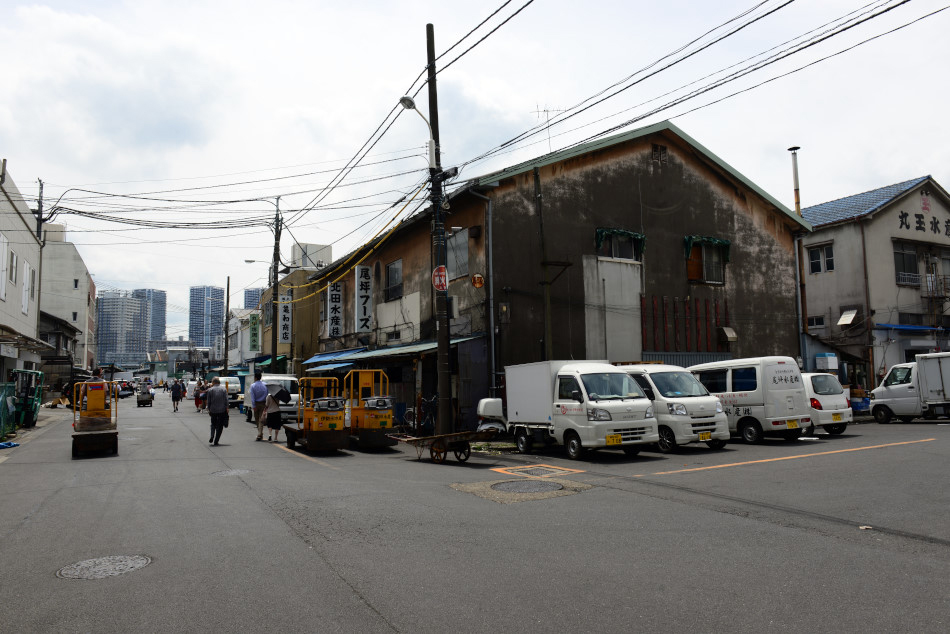 This time, we didn’t enter the wholesale area of the Inner Market. We didn’t want to stand in the way of the busy staff.
This time, we didn’t enter the wholesale area of the Inner Market. We didn’t want to stand in the way of the busy staff.
 We walked to the lanes of eateries and sushi bars to hunt for a place for breakfast.
We walked to the lanes of eateries and sushi bars to hunt for a place for breakfast.
 Japanese grilled omelette or tamagoyaki (玉子焼き) could also be found in the Inner Market area.
Japanese grilled omelette or tamagoyaki (玉子焼き) could also be found in the Inner Market area.
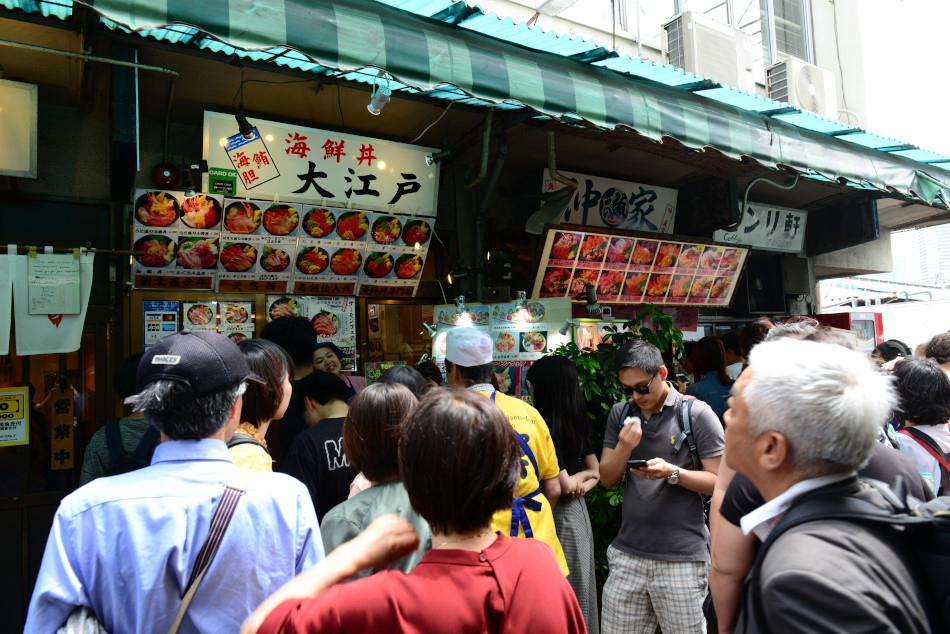 In 2014, we came to the Inner Market in early morning and had a bowl of chirashi for breakfast.
In 2014, we came to the Inner Market in early morning and had a bowl of chirashi for breakfast.
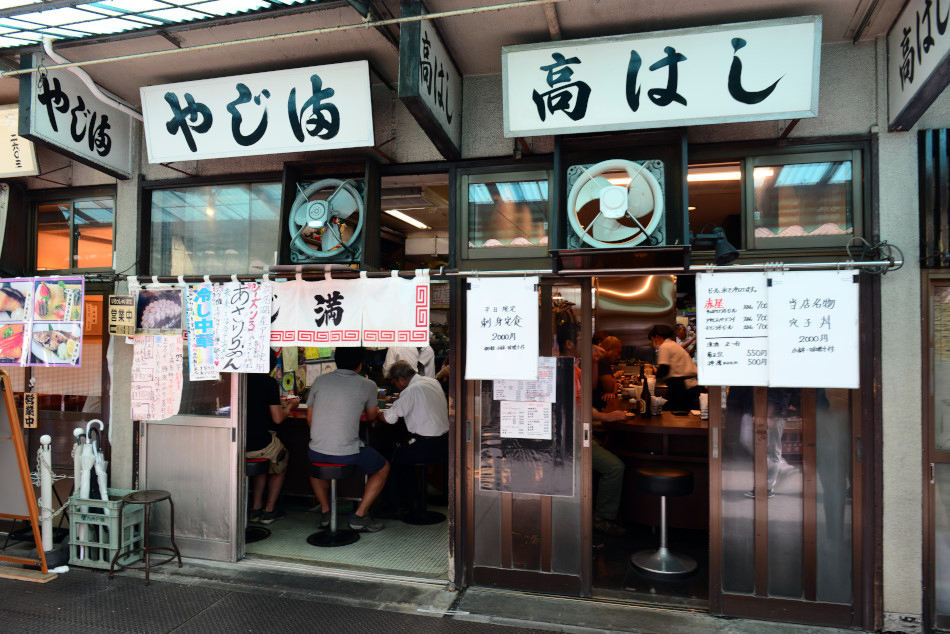 Other than chirashi and sushi, there were also other options such as curry and tempura.
Other than chirashi and sushi, there were also other options such as curry and tempura.
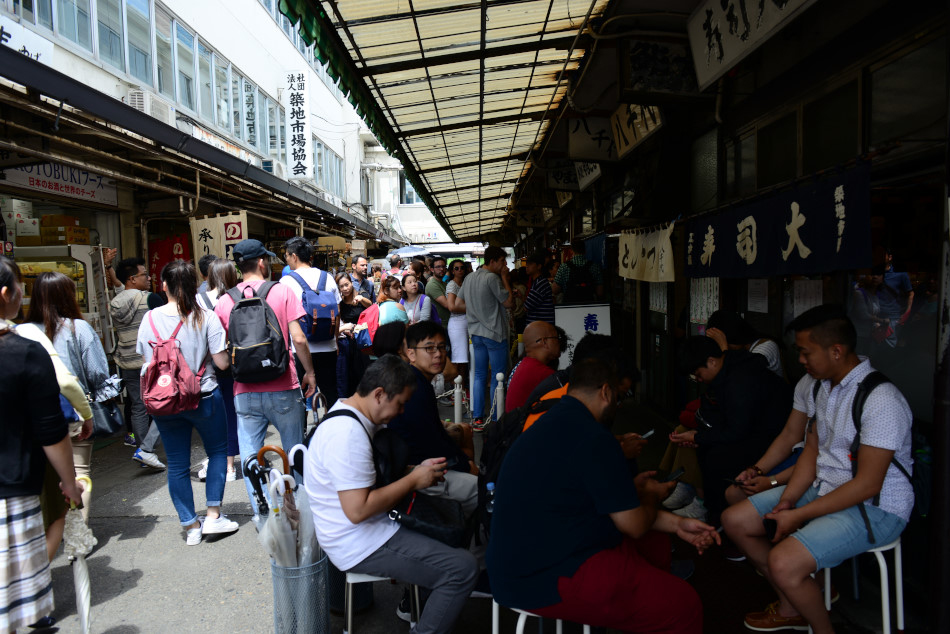 The line for Sushi Dai went all the way to the other side of the building out onto the adjacent lane. It seemed like a two hour wait at least.
The line for Sushi Dai went all the way to the other side of the building out onto the adjacent lane. It seemed like a two hour wait at least.
 This time, we picked Daiwa Sushi (大和寿司). Daiwa Sushi occupies two stores so we thought the queue wouldn’t be too long. We wouldn’t mind queuing for a while to have a chance to taste the fresh nigirizushi or hand pressed sushi (握り寿司) from Tsukiji Market.
This time, we picked Daiwa Sushi (大和寿司). Daiwa Sushi occupies two stores so we thought the queue wouldn’t be too long. We wouldn’t mind queuing for a while to have a chance to taste the fresh nigirizushi or hand pressed sushi (握り寿司) from Tsukiji Market.
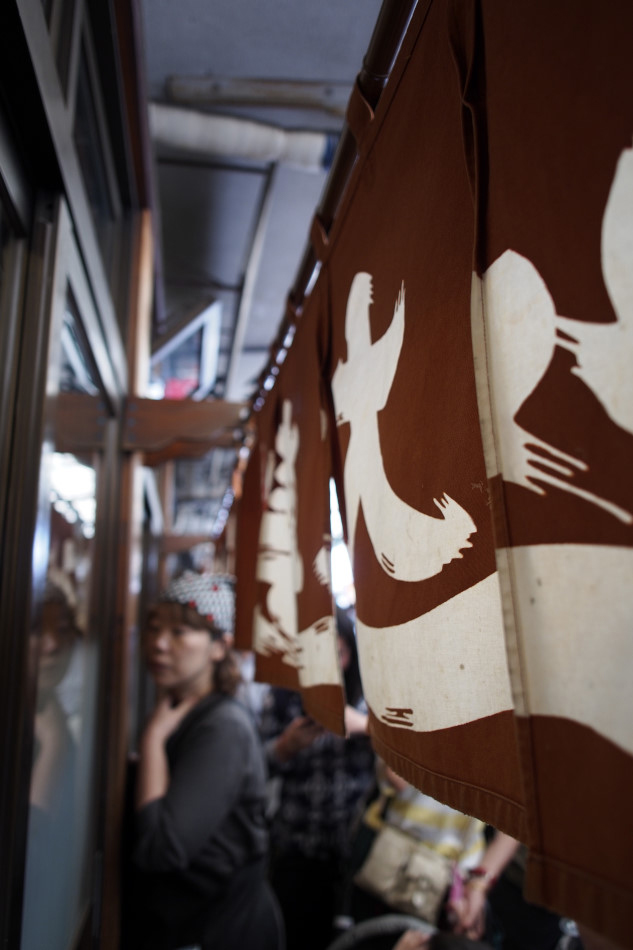 At the door of Daiwa Sushi, a staff was responsible to monitor the queue and direct the entering customers when seats became available in the restaurant.
At the door of Daiwa Sushi, a staff was responsible to monitor the queue and direct the entering customers when seats became available in the restaurant.
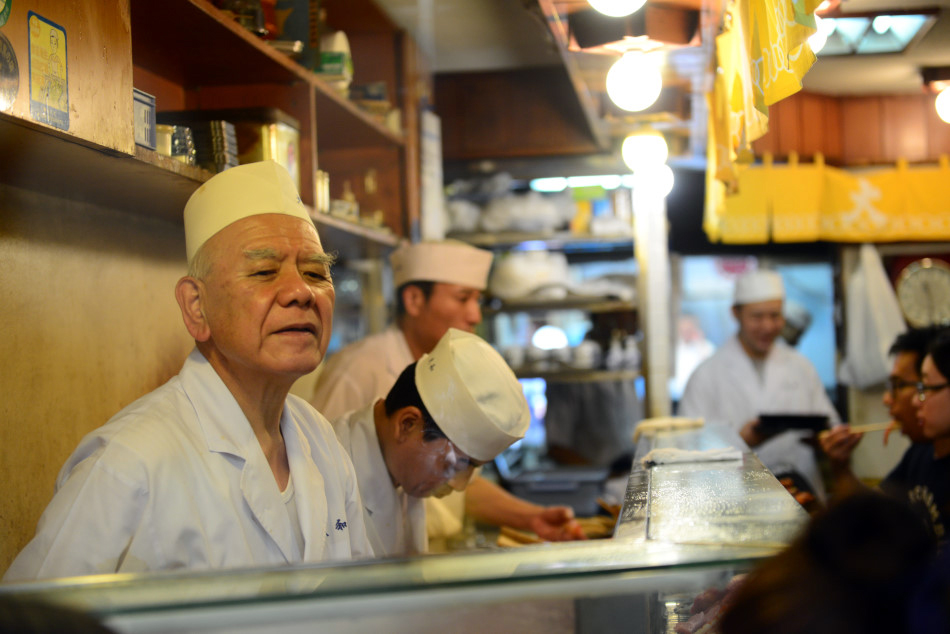 Through the window, we could see a senior itamae (chef) and his apprentices busy preparing nigirizushi for customers.
Through the window, we could see a senior itamae (chef) and his apprentices busy preparing nigirizushi for customers.
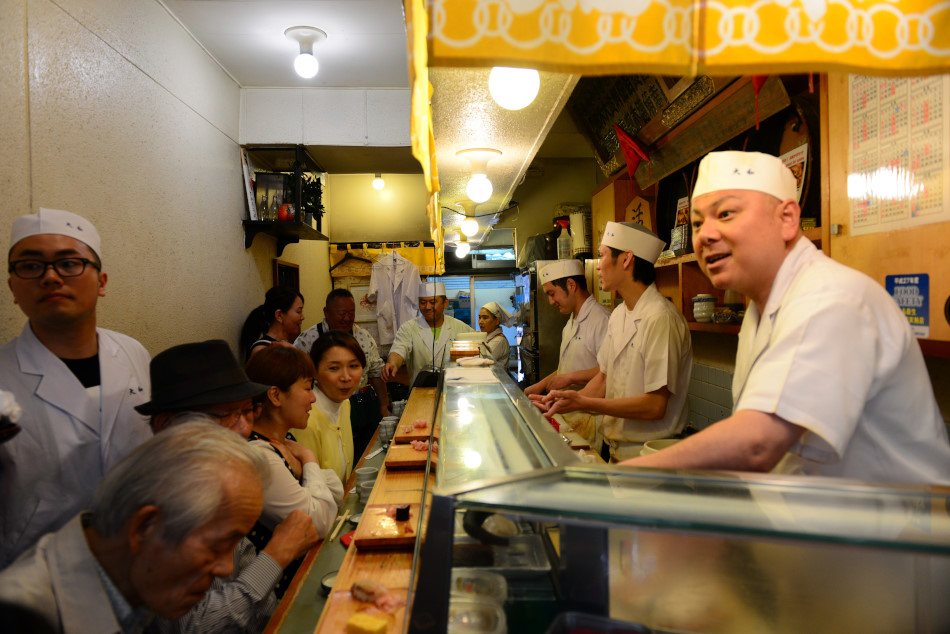 We ended up queuing for a little over an hour before finding ourselves sitting at the bar seats of Daiwa Sushi.
We ended up queuing for a little over an hour before finding ourselves sitting at the bar seats of Daiwa Sushi.
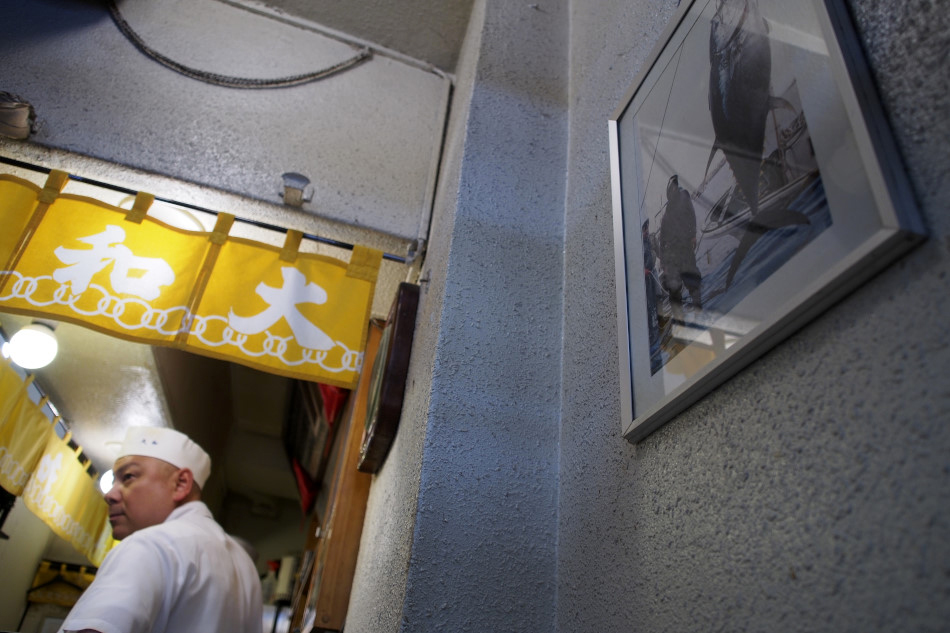 The interior was down to earth. We sat by the corner right by a photo depicting the catch of a huge tuna.
The interior was down to earth. We sat by the corner right by a photo depicting the catch of a huge tuna.
 There was only one nigirizushi (握り寿司) set option to order. Nothing fancy about the sushi, but the freshness of the fish and the vibrant market atmosphere made all the wait worthwhile.
There was only one nigirizushi (握り寿司) set option to order. Nothing fancy about the sushi, but the freshness of the fish and the vibrant market atmosphere made all the wait worthwhile.
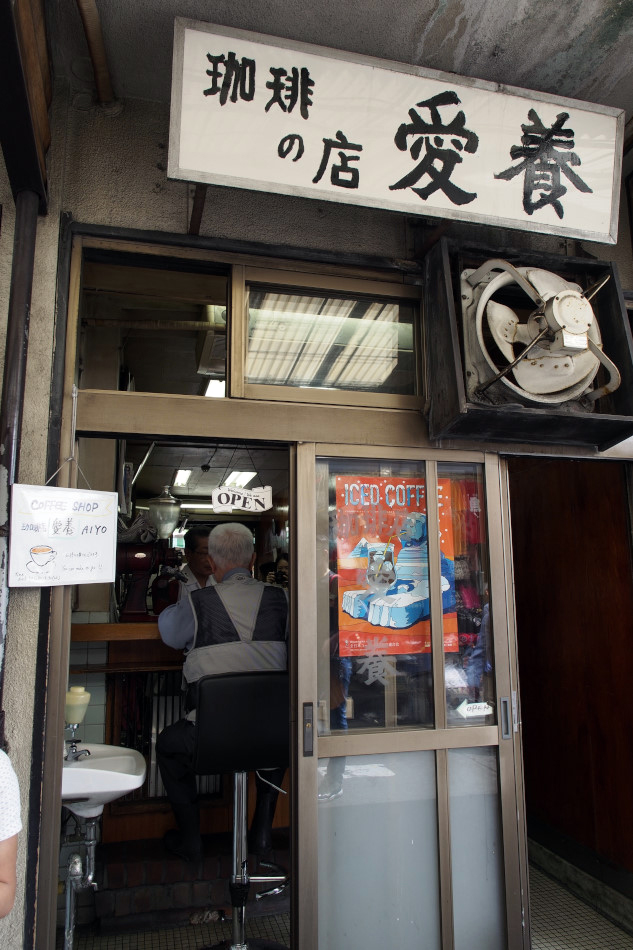 After the sushi breakfast, we hopped to Aiyo Cafe next door for a cup of coffee.
After the sushi breakfast, we hopped to Aiyo Cafe next door for a cup of coffee.
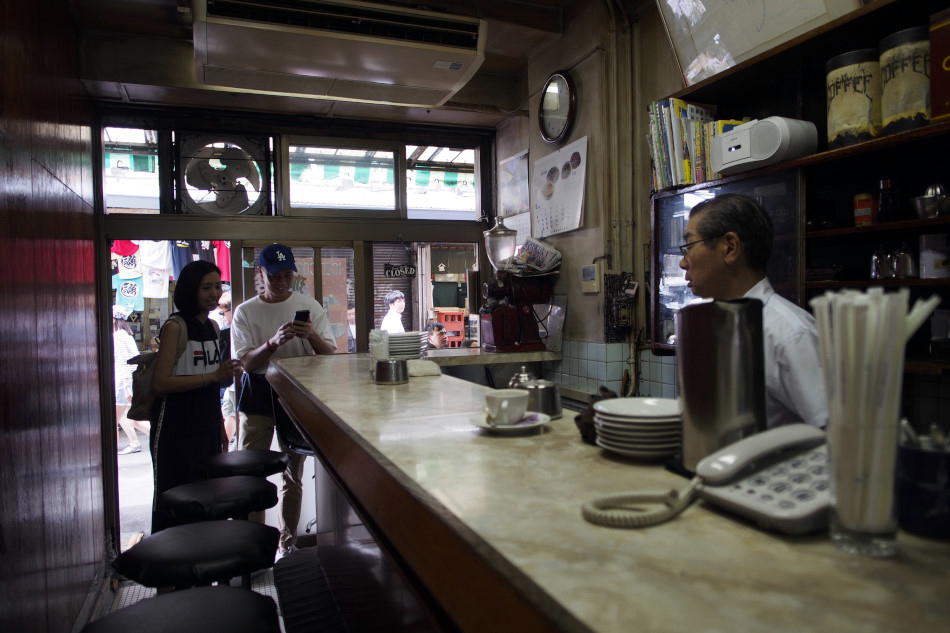 The interior of Aiyo revealed a strong vintage atmosphere.
The interior of Aiyo revealed a strong vintage atmosphere.
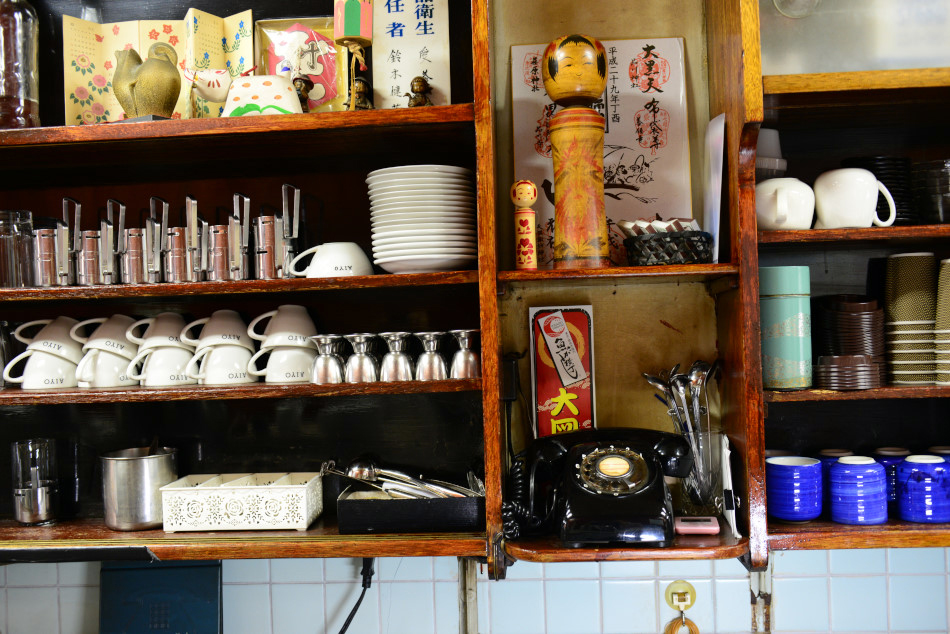 The entire shop seemed frozen in time since mid 20th century.
The entire shop seemed frozen in time since mid 20th century.
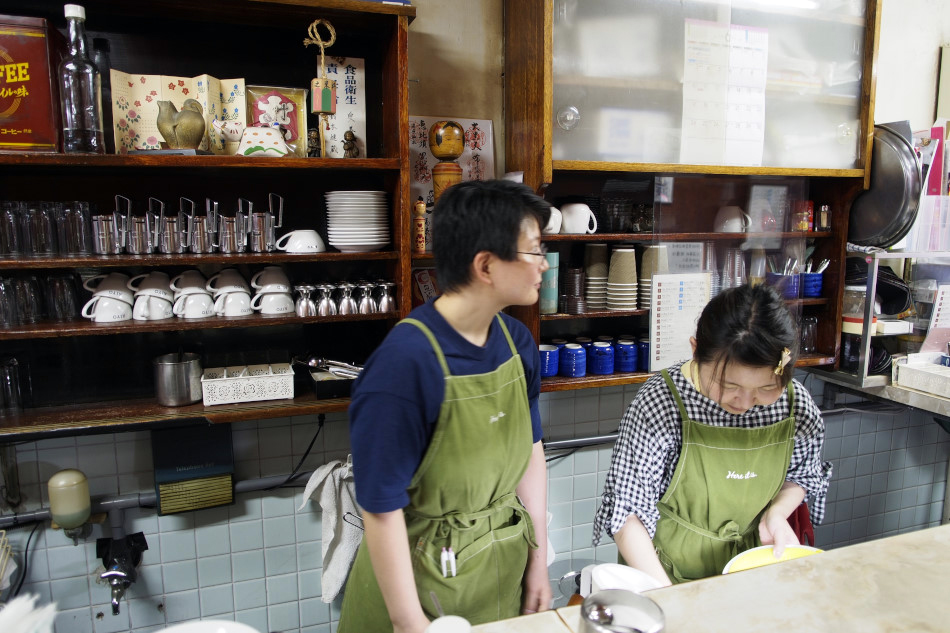 The staff were very friendly and spoke some English.
The staff were very friendly and spoke some English.
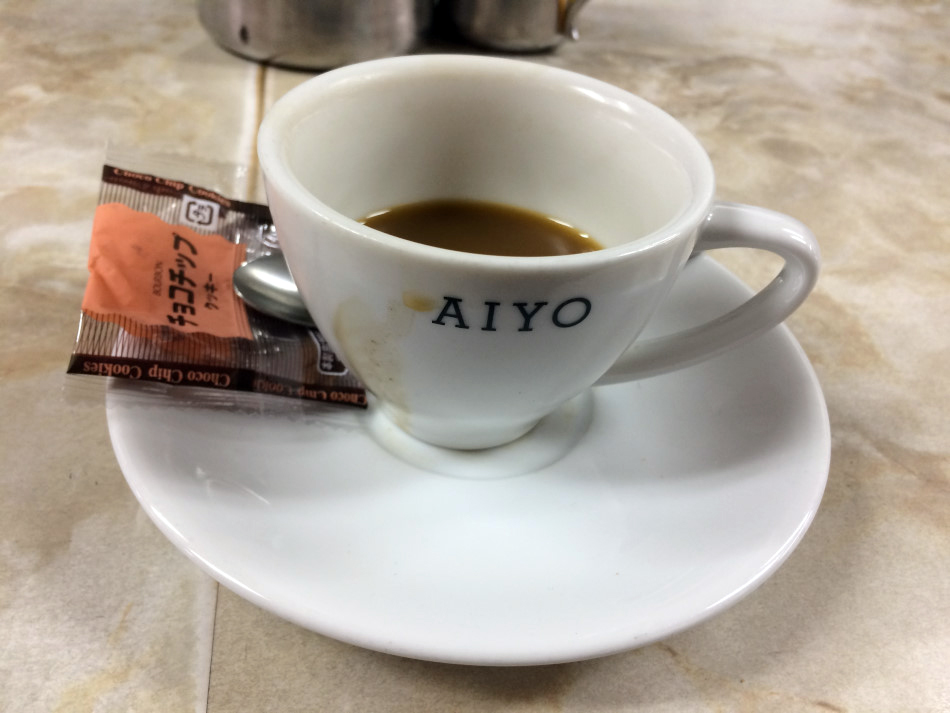 We had a good time exchange a few words with them while taking a short coffee break. After all, we were a little sleepy after the red-eye flight.
We had a good time exchange a few words with them while taking a short coffee break. After all, we were a little sleepy after the red-eye flight.
 At another lane there were restaurants that offered Western cuisine. We thought of trying but were too full after the sushi breakfast.
At another lane there were restaurants that offered Western cuisine. We thought of trying but were too full after the sushi breakfast.
 We walked by an interesting sliding door panel leaning against a low wall outside the row of restaurants that offered Western food. Was the move to Toyosu already underway for some restaurant owners we did not know.
We walked by an interesting sliding door panel leaning against a low wall outside the row of restaurants that offered Western food. Was the move to Toyosu already underway for some restaurant owners we did not know.
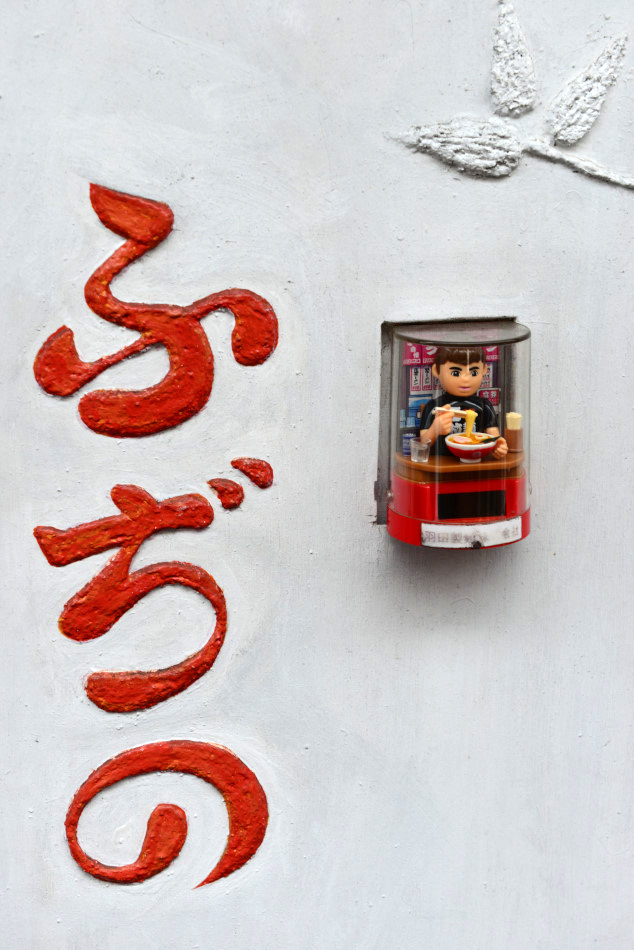 Judging from the mini figure that actually moved continuously as if devouring a bowl of delicious noodles, the door might belong to a ramen restaurant. After the sushi and coffee, we decided to move on to Roppongi for a dose of design culture.
Judging from the mini figure that actually moved continuously as if devouring a bowl of delicious noodles, the door might belong to a ramen restaurant. After the sushi and coffee, we decided to move on to Roppongi for a dose of design culture.
* * *
CHUBU (中部地方) 2018, Japan, 2018.05.25 – 06.03
Introduction
Day 1: Tokyo (東京)
1.1 TSUKIJI OUTER MARKET (築地場外市場)
1.2 TSUKIJI INNER MARKET (築地中央卸売市場)
1.3 MORI ART MUSEUM (森美術館), 21_21 DESIGN SIGHT & CAFE KITSUNE
Day 2: Matsumoto (松本)& Kamikochi (上高地)
2.1 MATSUMOTO CASTLE (松本城), Matsumoto (松本)
2.2 “ALL ABOUT MY LOVE”, Yayoi Kusama’s Exhibition at Matsumoto City Museum of Art (松本市美術館), Matsumoto (松本)
2.3 MATSUMOTO PERFORMING ARTS CENTER (まつもと市民芸術館), Matsumoto (松本)
2.4 FROM MATSUMOTO (松本) TO KAMIKOCHI (上高地)
2.5 ARRIVAL IN KAMIKOCHI (上高地), Chūbu-Sangaku National Park (中部山岳国立公園)
Day 3: Kamikochi (上高地)
3.1 MORNING WALK IN KAMIKOCHI (上高地), Nagano Prefecture (長野県)
3.2 DAKESAWA HIKE (岳沢), Kamikochi (上高地)
Day 4: Kamikochi (上高地) & Shirahone Onsen (白骨温泉)
4.1 TAISHO POND (大正池), Kamikochi (上高地)
4.2 RETREAT IN THE JAPANESE ALPS, Shirahone Onsen (白骨温泉)
4.3 MOMENTS OF ESCAPE, Tsuruya Ryokan (つるや旅館), Shirahone Onsen (白骨温泉)
Day 5: Hida-Takayama (飛騨高山)
5.1 CITY IN THE MOUNTAINS, Hida-Takayama (飛騨高山)
5.2 HIDA BEEF (飛騨牛), Hida-Takayama (飛騨高山)
5.3 SAKE (日本酒) BREWERIES, Hida-Takayama (飛騨高山)
5.4 YOSHIJIMA HOUSE (吉島家住宅), Hida-Takayama (飛騨高山)
5.5 HIGASHIYAMA WALKING COURSE (東山遊歩道), Hida-Takayama (飛騨高山)
Day 6: Hida-Takayama (飛騨高山), Shirakawa-go (白川郷) & Ainokura (相倉)
6.1 MIYAGAWA MORNING MARKET (宮川朝市), Hida-Takayama (飛騨高山), Gifu Prefecture (岐阜県)
6.2 OGIMACHI IN THE RAIN, Shirakawa-go (白川郷), Gifu Prefecture (岐阜県)
6.3 SOBA, TEMPLE & LOOKOUT, Shirakawa-go (白川郷)
6.4 RAINY AFTERNOON IN AINOKURA (相倉), Gokayama (五箇山)
6.5 GASSHO MINSHUKU, FLOWER BEDS & RICE PADDY FIELDS, Ainokura (相倉), Gokayama (五箇山)
6.6 CROAKING FROGS AND MOONLIGHT REFLECTIONS, Gokayama (五箇山)
Day 7: Kanazawa (金沢)
7.1 DEPARTURE IN THE RAIN, Ainokura (相倉) to Kanazawa (金沢)
7.2 A SEAFOOD PARADISE – OMICHO MARKET (近江町市場)
7.3 D T Suzuki Museum (鈴木大拙館)
7.4 Kenroku-en Garden (兼六園)
7.5 Oyama Shrine (尾山神社) and Nagamachi Samurai District (長町)
7.6 Nomura Samurai House (武家屋敷跡 野村家), Nagamachi Samurai District (長町)
7.7 Sushi Ippei (一平鮨), Katamachi (片町)
Day 8: Kanazawa, Ishikawa Prefecture (金沢, 石川県)
8.1 Iki Iki Tei (いきいき亭) and Higashide Coffee (東出珈琲店), Omicho Market (近江町市場)
8.2 21st Century Museum of Contemporary Art (21世紀美術館)
8.3 Kazuemachi District (主計町茶屋街)
8.4 Higashi Chaya District (東山ひがし茶屋街)
8.5 Kaga Yuzen Toro Nagashi (加賀友禅燈ろう流し), Asano River (浅野川)
8.6 AFTERMATH OF KAGA YUZEN TORO NAGASHI (加賀友禅燈ろう流し)
Day 9 & 10: Tokyo (東京)
9.1 Marunouchi (丸の内) & Nihonbashi (日本橋)
10.1 OEDO ANTIQUE MARKET (大江戸骨董市), Tokyo Forum (東京国際フォーラム)
10.2 FARMER’S MARKET, United Nations University (東京国連大学), Aoyama (青山)
DAY 1 (1/3): TSUKIJI OUTER MARKET (築地場外市場), Tokyo, Japan, 2018.05.25
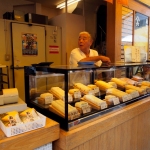
Walking out of Tsukiji Metro Station, our attention immediately fell to the monumental Tsukiji Honganji Temple (築地本願寺) across the street. Design in mixed styles including Indian Buddhist, Islamic and Hindu, as well as Western Neoclassical influences, architect and Tokyo University professor Chuta Ito intended to steer away from the traditional East Asian timber architectural traditions. Instead, he traveled to India numerous times to visit temples, and brought home design touches from the birthplace of Buddhism. The 1923 Great Kanto Earthquake destroyed the temple’s predecessor. The current Honganji Temple was built in the 1930s, and soon became a prominent Jodo Shinshu (浄土真宗) temple in Tokyo. We climbed the main stair and entered the main hall through an elegant doorway with beautiful stain-glass transom windows overhead. We were surprised to see a full house of audience in the cathedral-like main hall (even with an organ). Apparently there was a concert going on. A female vocalist was performing some kind of Western opera inside the temple.
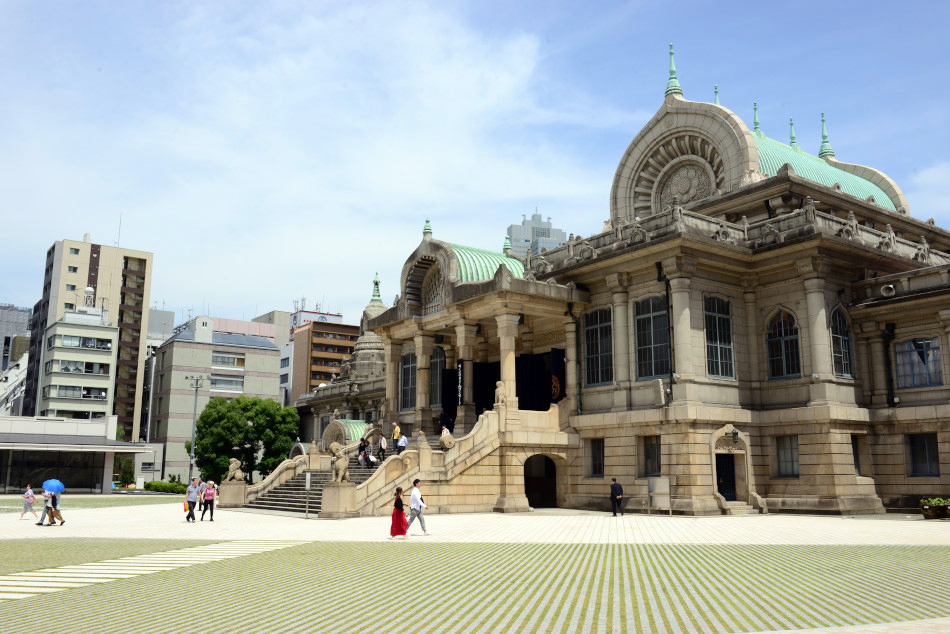 The unique facade of Tsukiji Honganji Temple hardly revealed its true identity of to us.
The unique facade of Tsukiji Honganji Temple hardly revealed its true identity of to us.
 The elegant stain glass transom over the doorway depict the Buddhist icon of lotus flowers.
The elegant stain glass transom over the doorway depict the Buddhist icon of lotus flowers.
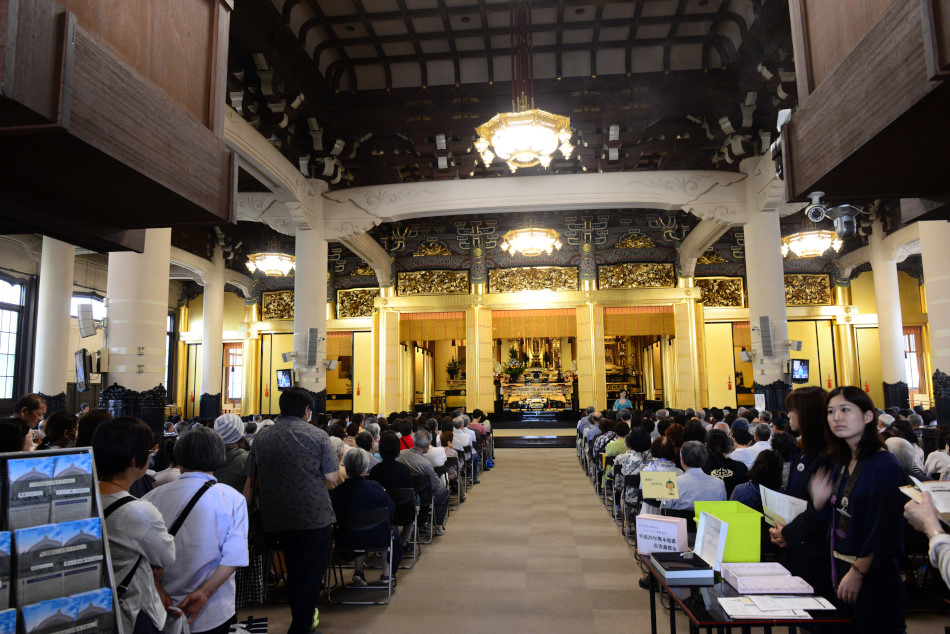 There was a concert inside the main hall of Tsukiji Honganji Temple.
There was a concert inside the main hall of Tsukiji Honganji Temple.
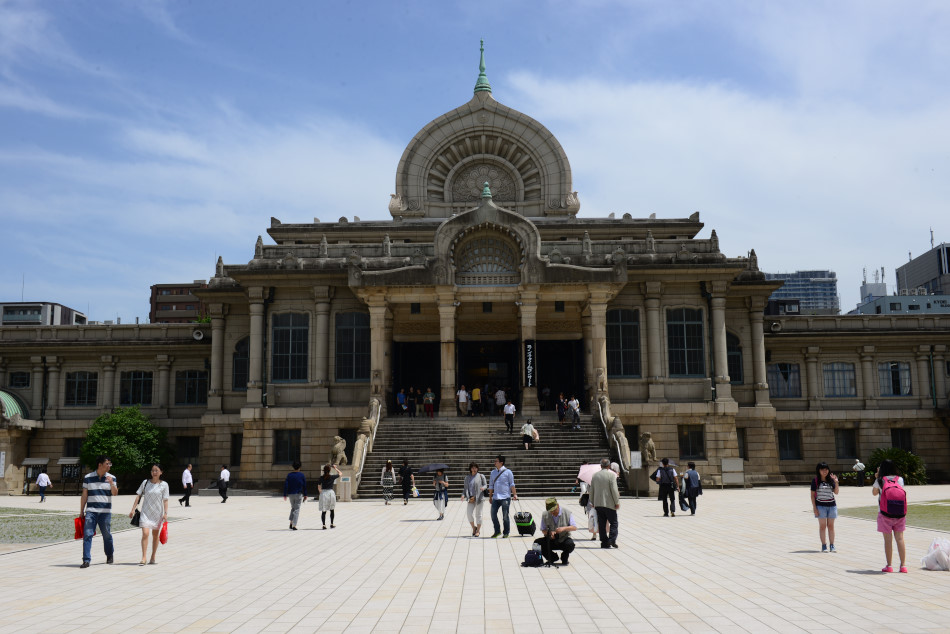 The architecture of Tsukiji Honganji Temple presents the trend of cultural fusion back in early 20th century.
The architecture of Tsukiji Honganji Temple presents the trend of cultural fusion back in early 20th century.
Across the street adjacent to the Tsukiji Honganji Temple, we picked a small lane leading into Tsukiji Jogai Shijo (築地場外市場) or the Outer Market. Encompassing a few blocks adjacent to the Tsukiji Jonai Shijo or the Inner Market, the Outer Market is a popular tourism attraction. Catered for the public, small shops selling all kinds of culinary-related goods from dried seafood to kitchen knives and food stalls offering a wide range of snacks such as sushi and grilled egg, the pedestrianized lanes of the Outer Market is truly a foodie’s paradise. On this piece of reclaimed land (Tsukiji literally means reclaimed land), the eateries and shops of the Outer Market had long been providing a diverse range of food to the people of Tokyo since the Showa Era (1926-1989). The entire Tsukiji Market was in fact a consequence of the Great Kanto Earthquake, which devastated Central Tokyo in 1923 including the Nihonbashi Fish Market. The fish market was relocated to Tsukiji and began to operate in 1935 as one of the three major markets in the city. Already the largest wholesale seafood market in the world, the Tsukiji Market is running out of space for further development. Work of relocating the market has been undergoing for sometime. After several delays, it seems that the market is really moving to its new home in Toyosu (豊洲) this October. But that didn’t affect the bustling Outer Market as these few blocks of shops and eateries (and the loads of tourists) would likely to stay even after the move.
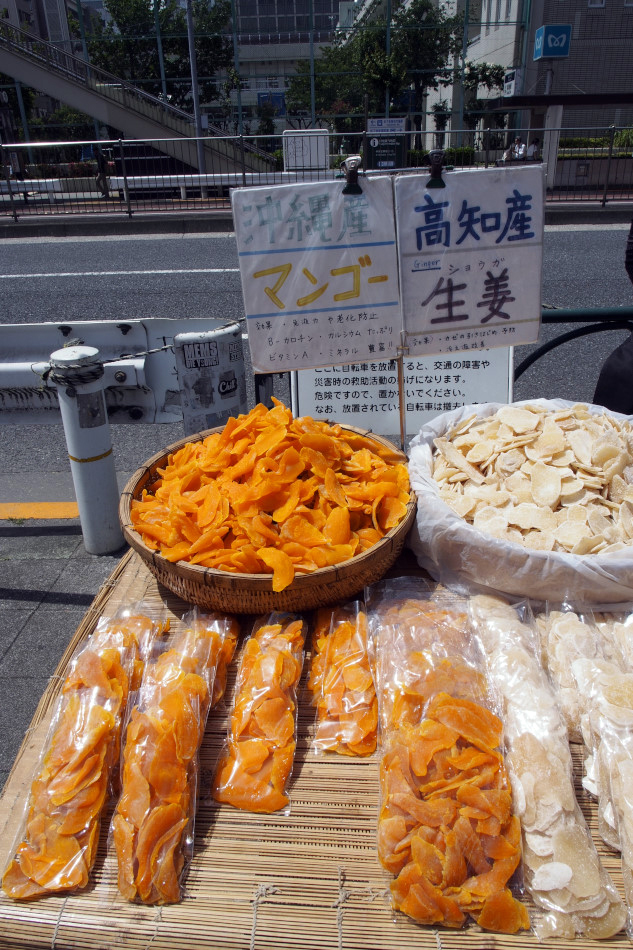 Street vendors appeared blocks away from the Tsukiji Market just outside the Metro Station.
Street vendors appeared blocks away from the Tsukiji Market just outside the Metro Station.
 A large fish painted on the building facade probably reminds tourists the direction of the market.
A large fish painted on the building facade probably reminds tourists the direction of the market.
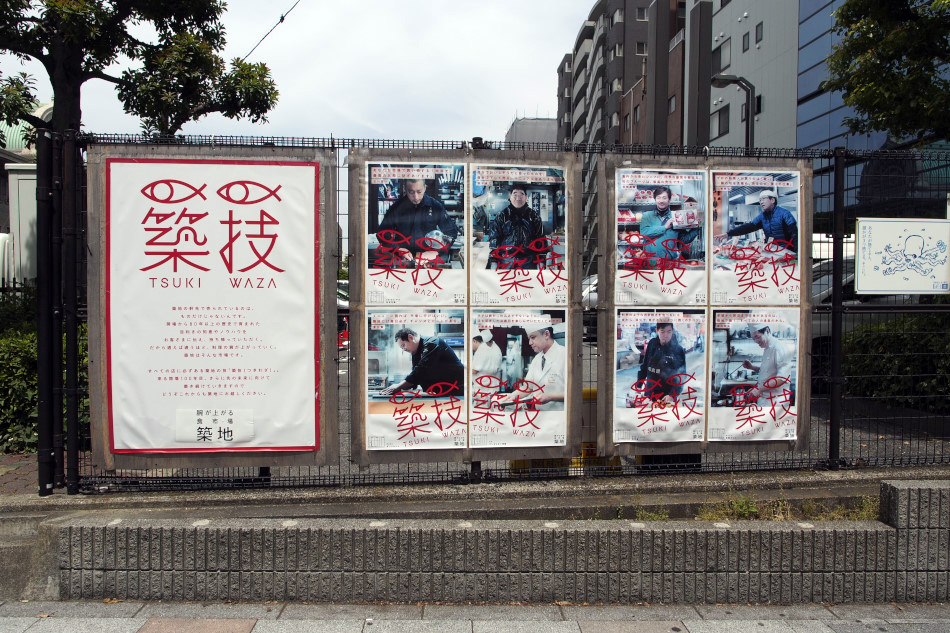 A relatively new market called “Tsuki Waza” will remain at Tsukiji even after the relocation of Tsukiji Inner Market.
A relatively new market called “Tsuki Waza” will remain at Tsukiji even after the relocation of Tsukiji Inner Market.
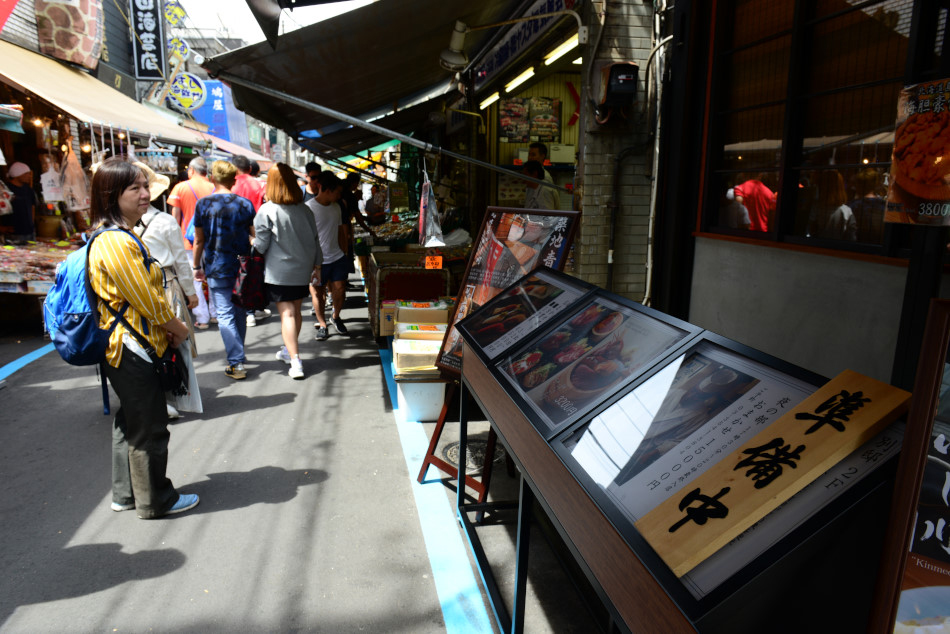 The Tsukiji Outer Market is consisted of a few pedestrianized streets of shops and restaurants.
The Tsukiji Outer Market is consisted of a few pedestrianized streets of shops and restaurants.
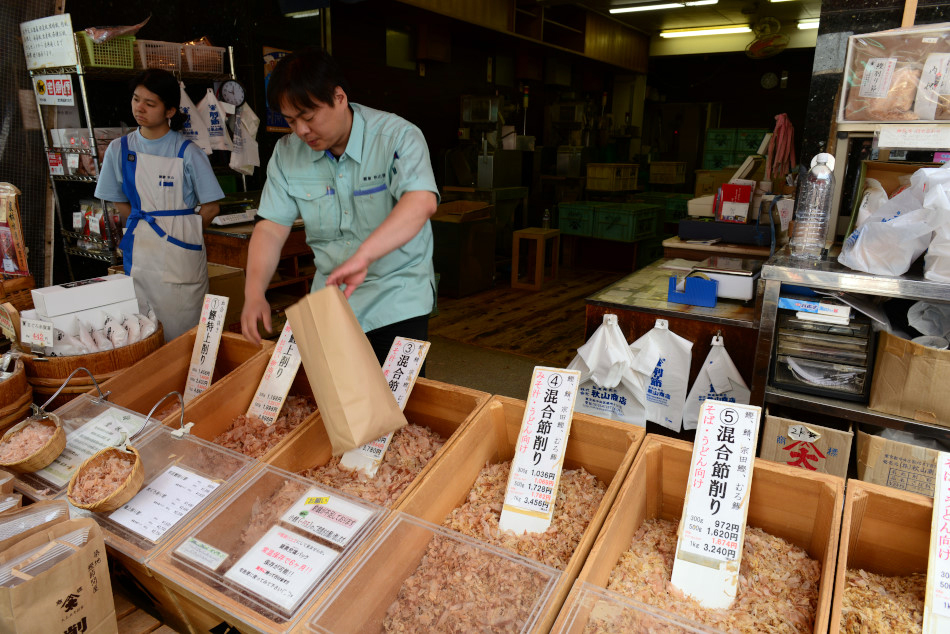 Katsuobushi (鰹節) is the dried, fermented and smoked skipjack tuna or bonito flakes commonly seen in Japanese cuisine.
Katsuobushi (鰹節) is the dried, fermented and smoked skipjack tuna or bonito flakes commonly seen in Japanese cuisine.
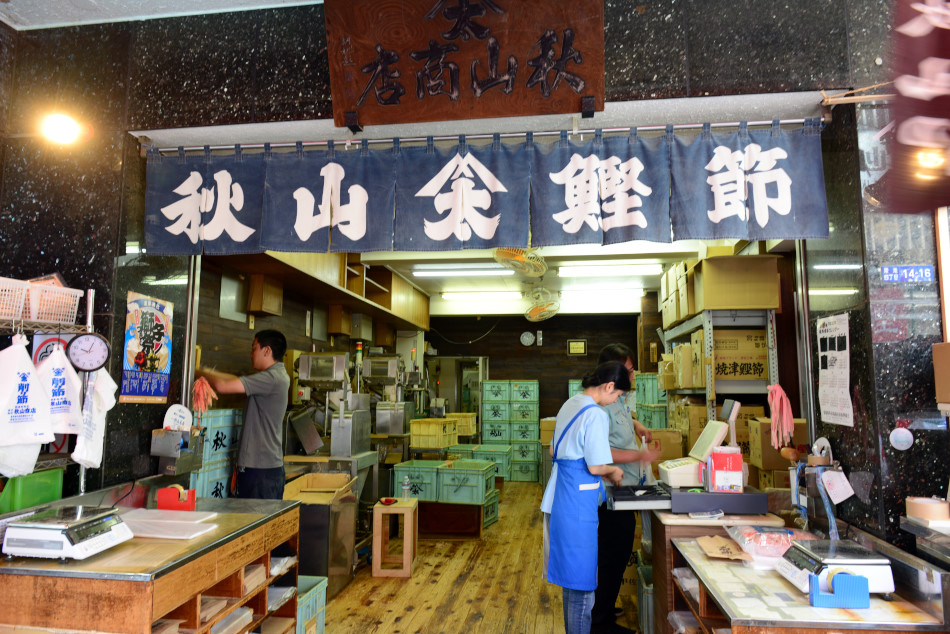 Akiyama Shouten (秋山商店) specializes in katsuobushi. We couldn’t resist but got ourselves 500g of the flakes.
Akiyama Shouten (秋山商店) specializes in katsuobushi. We couldn’t resist but got ourselves 500g of the flakes.
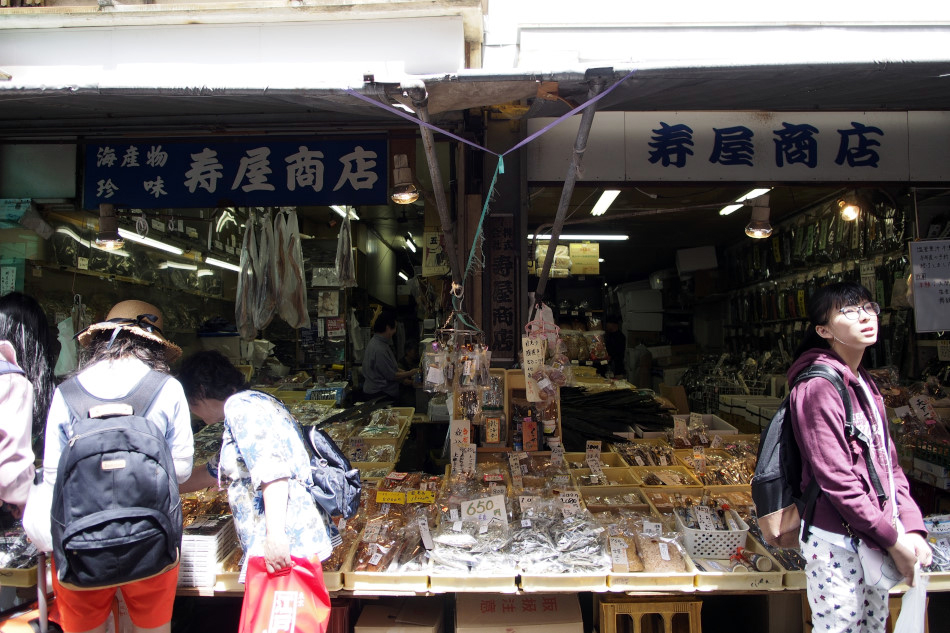 There are many small shops with all kinds of dried seafood and seaweed.
There are many small shops with all kinds of dried seafood and seaweed.
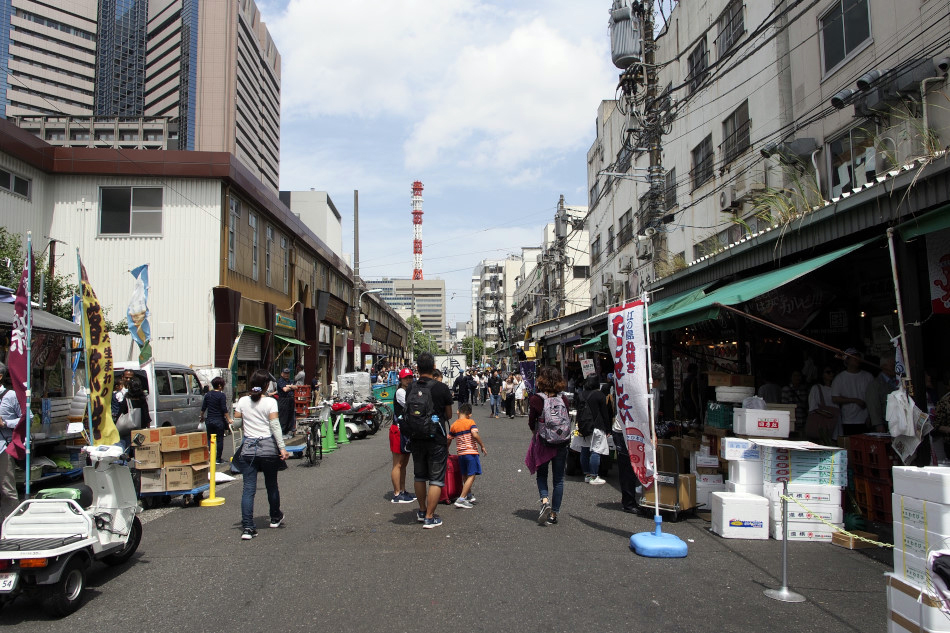 While it only occupies a few blocks, one can easily get disoriented in Tsukiji Outer Market.
While it only occupies a few blocks, one can easily get disoriented in Tsukiji Outer Market.
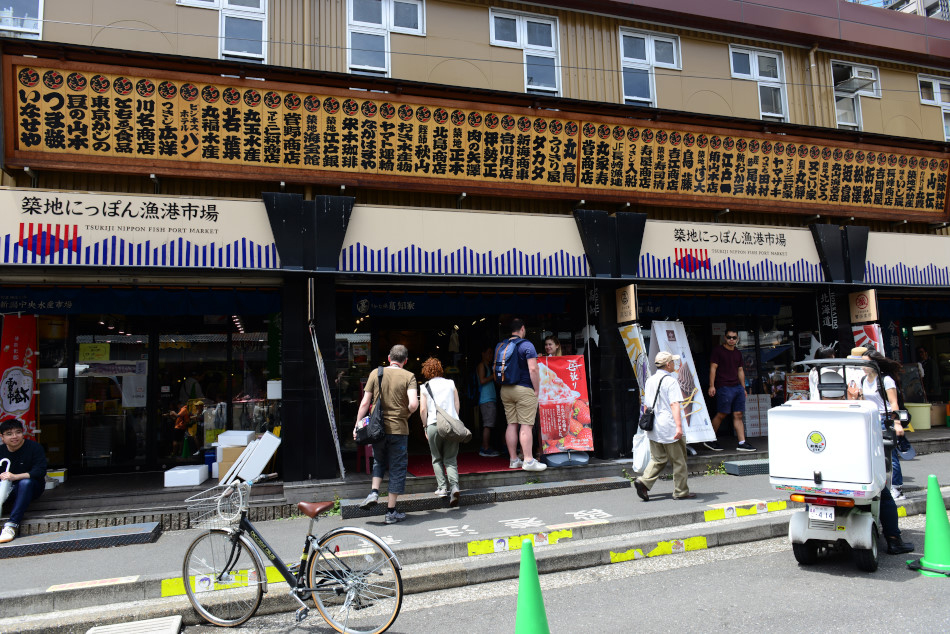 Apart from the small shops, there are also indoor shopping arcades of food stalls.
Apart from the small shops, there are also indoor shopping arcades of food stalls.
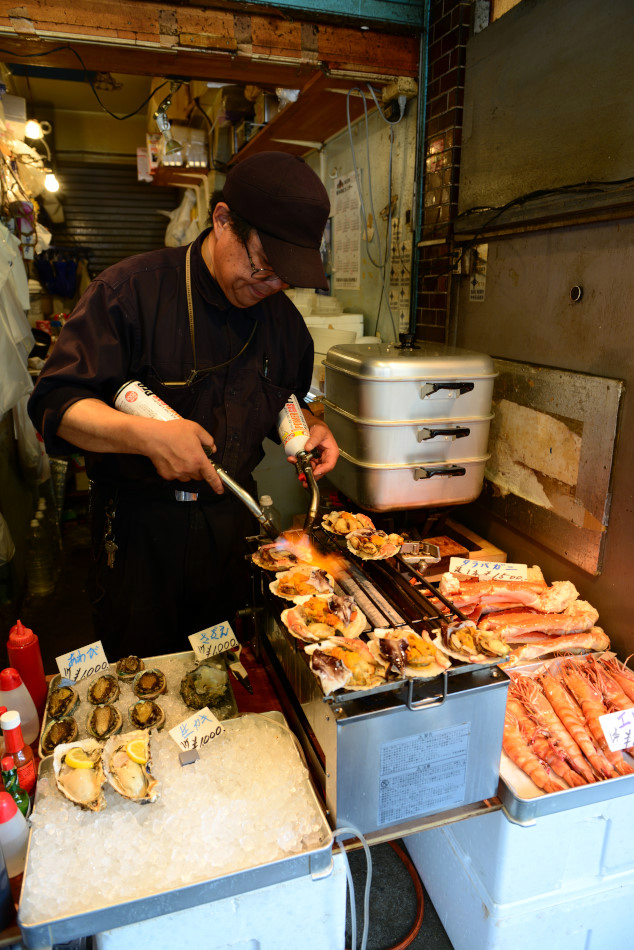 We ended up get our first snacks from a street BBQ vendor.
We ended up get our first snacks from a street BBQ vendor.
 Apart from seafood, spices can also be found in the Outer Market.
Apart from seafood, spices can also be found in the Outer Market.
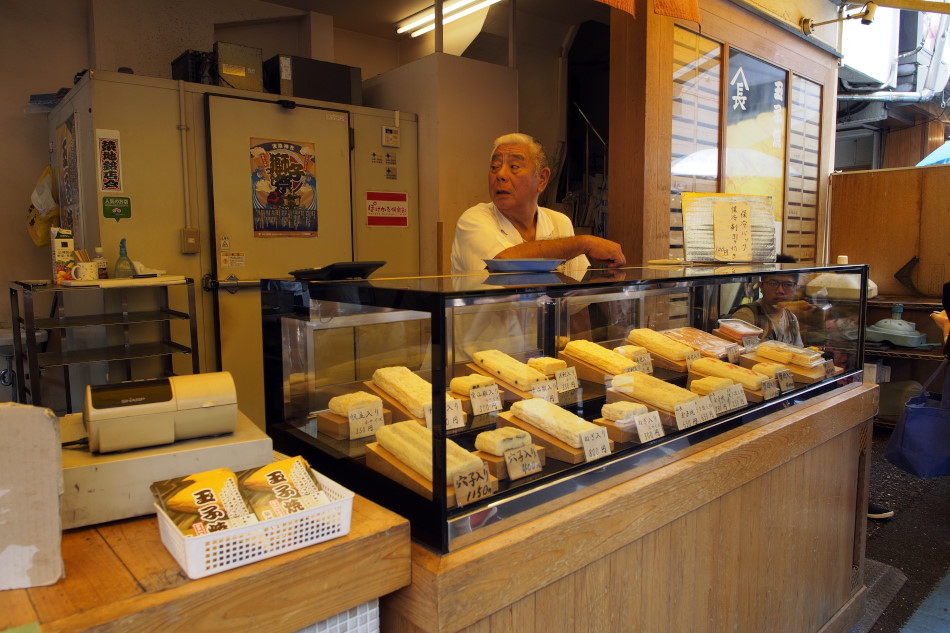 Tamagoyaki (玉子焼き) or grilled omelette is another popular snacks available at Tsukiji.
Tamagoyaki (玉子焼き) or grilled omelette is another popular snacks available at Tsukiji.
 We saw about four to five stalls specialized in tamagoyaki. We tried two of them and they both tasted good.
We saw about four to five stalls specialized in tamagoyaki. We tried two of them and they both tasted good.
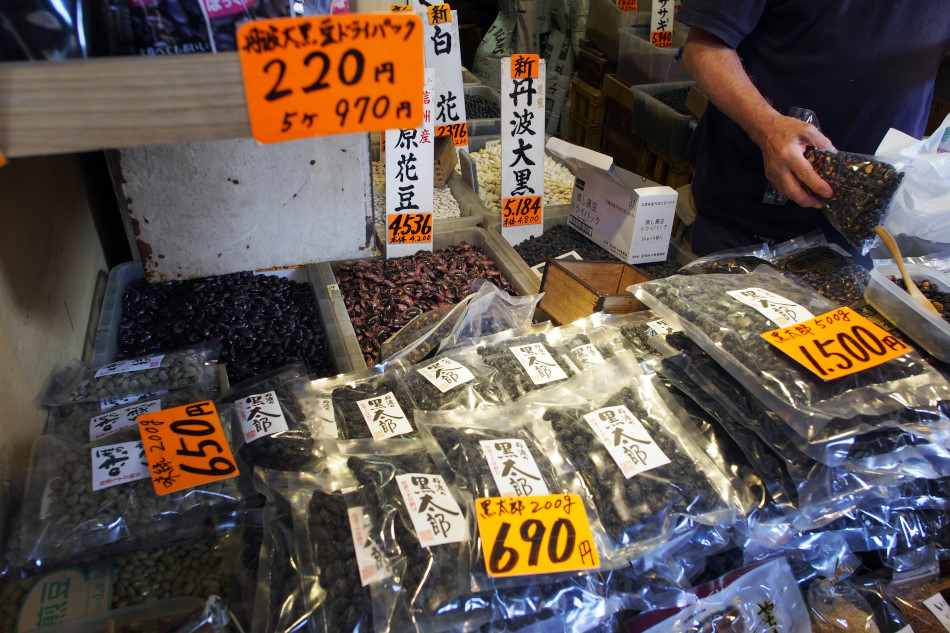 After free tasting of black beans from Kyoto region we ended up get a pack home.
After free tasting of black beans from Kyoto region we ended up get a pack home.
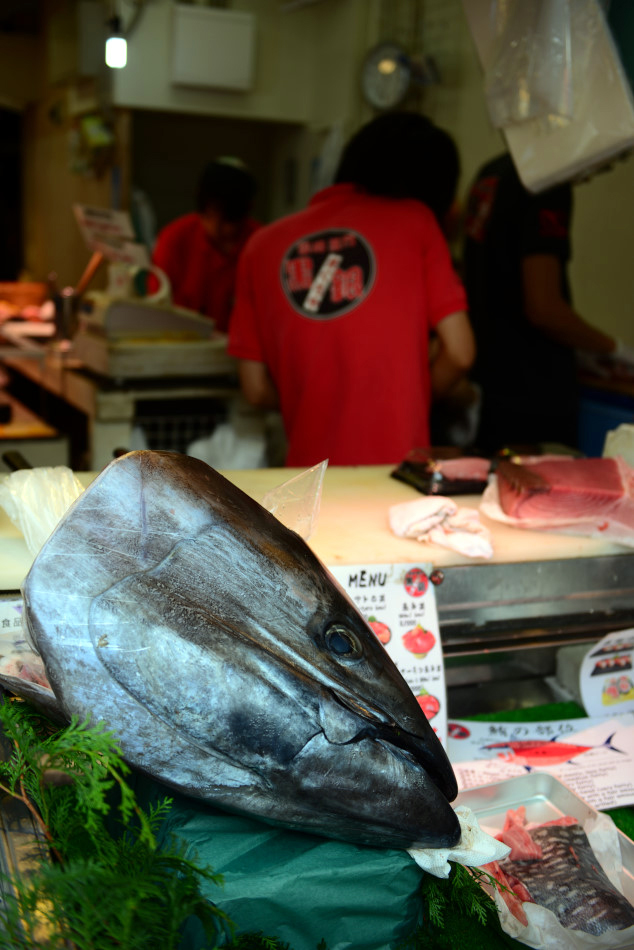 After all, tuna is still the king in Tsukiji. Quite a long queue of people were waiting for fresh tuna sashimi in front of this shop.
After all, tuna is still the king in Tsukiji. Quite a long queue of people were waiting for fresh tuna sashimi in front of this shop.
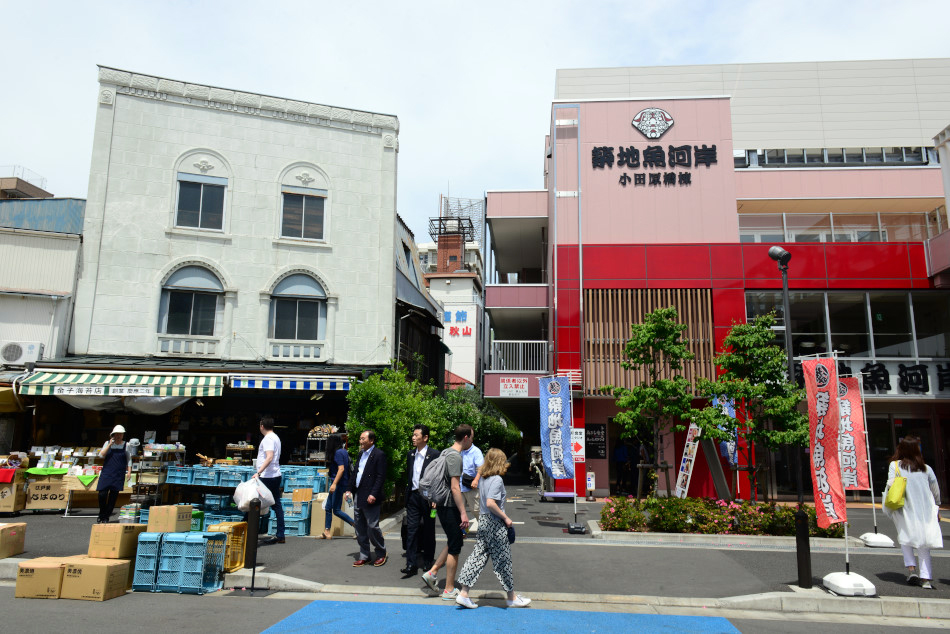 New indoor shopping arcades have been established in recent years at the Outer Market, perhaps as a gesture of confidence for the future of Tsukiji after the relocation of the wholesale Inner Market later this year.
New indoor shopping arcades have been established in recent years at the Outer Market, perhaps as a gesture of confidence for the future of Tsukiji after the relocation of the wholesale Inner Market later this year.
* * *
CHUBU (中部地方) 2018, Japan, 2018.05.25 – 06.03
Introduction
Day 1: Tokyo (東京)
1.1 TSUKIJI OUTER MARKET (築地場外市場)
1.2 TSUKIJI INNER MARKET (築地中央卸売市場)
1.3 MORI ART MUSEUM (森美術館), 21_21 DESIGN SIGHT & CAFE KITSUNE
Day 2: Matsumoto (松本)& Kamikochi (上高地)
2.1 MATSUMOTO CASTLE (松本城), Matsumoto (松本)
2.2 “ALL ABOUT MY LOVE”, Yayoi Kusama’s Exhibition at Matsumoto City Museum of Art (松本市美術館), Matsumoto (松本)
2.3 MATSUMOTO PERFORMING ARTS CENTER (まつもと市民芸術館), Matsumoto (松本)
2.4 FROM MATSUMOTO (松本) TO KAMIKOCHI (上高地)
2.5 ARRIVAL IN KAMIKOCHI (上高地), Chūbu-Sangaku National Park (中部山岳国立公園)
Day 3: Kamikochi (上高地)
3.1 MORNING WALK IN KAMIKOCHI (上高地), Nagano Prefecture (長野県)
3.2 DAKESAWA HIKE (岳沢), Kamikochi (上高地)
Day 4: Kamikochi (上高地) & Shirahone Onsen (白骨温泉)
4.1 TAISHO POND (大正池), Kamikochi (上高地)
4.2 RETREAT IN THE JAPANESE ALPS, Shirahone Onsen (白骨温泉)
4.3 MOMENTS OF ESCAPE, Tsuruya Ryokan (つるや旅館), Shirahone Onsen (白骨温泉)
Day 5: Hida-Takayama (飛騨高山)
5.1 CITY IN THE MOUNTAINS, Hida-Takayama (飛騨高山)
5.2 HIDA BEEF (飛騨牛), Hida-Takayama (飛騨高山)
5.3 SAKE (日本酒) BREWERIES, Hida-Takayama (飛騨高山)
5.4 YOSHIJIMA HOUSE (吉島家住宅), Hida-Takayama (飛騨高山)
5.5 HIGASHIYAMA WALKING COURSE (東山遊歩道), Hida-Takayama (飛騨高山)
Day 6: Hida-Takayama (飛騨高山), Shirakawa-go (白川郷) & Ainokura (相倉)
6.1 MIYAGAWA MORNING MARKET (宮川朝市), Hida-Takayama (飛騨高山), Gifu Prefecture (岐阜県)
6.2 OGIMACHI IN THE RAIN, Shirakawa-go (白川郷), Gifu Prefecture (岐阜県)
6.3 SOBA, TEMPLE & LOOKOUT, Shirakawa-go (白川郷)
6.4 RAINY AFTERNOON IN AINOKURA (相倉), Gokayama (五箇山)
6.5 GASSHO MINSHUKU, FLOWER BEDS & RICE PADDY FIELDS, Ainokura (相倉), Gokayama (五箇山)
6.6 CROAKING FROGS AND MOONLIGHT REFLECTIONS, Gokayama (五箇山)
Day 7: Kanazawa (金沢)
7.1 DEPARTURE IN THE RAIN, Ainokura (相倉) to Kanazawa (金沢)
7.2 A SEAFOOD PARADISE – OMICHO MARKET (近江町市場)
7.3 D T Suzuki Museum (鈴木大拙館)
7.4 Kenroku-en Garden (兼六園)
7.5 Oyama Shrine (尾山神社) and Nagamachi Samurai District (長町)
7.6 Nomura Samurai House (武家屋敷跡 野村家), Nagamachi Samurai District (長町)
7.7 Sushi Ippei (一平鮨), Katamachi (片町)
Day 8: Kanazawa, Ishikawa Prefecture (金沢, 石川県)
8.1 Iki Iki Tei (いきいき亭) and Higashide Coffee (東出珈琲店), Omicho Market (近江町市場)
8.2 21st Century Museum of Contemporary Art (21世紀美術館)
8.3 Kazuemachi District (主計町茶屋街)
8.4 Higashi Chaya District (東山ひがし茶屋街)
8.5 Kaga Yuzen Toro Nagashi (加賀友禅燈ろう流し), Asano River (浅野川)
8.6 AFTERMATH OF KAGA YUZEN TORO NAGASHI (加賀友禅燈ろう流し)
Day 9 & 10: Tokyo (東京)
9.1 Marunouchi (丸の内) & Nihonbashi (日本橋)
10.1 OEDO ANTIQUE MARKET (大江戸骨董市), Tokyo Forum (東京国際フォーラム)
10.2 FARMER’S MARKET, United Nations University (東京国連大学), Aoyama (青山)
